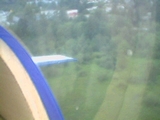Flying R/C Model Aircraft
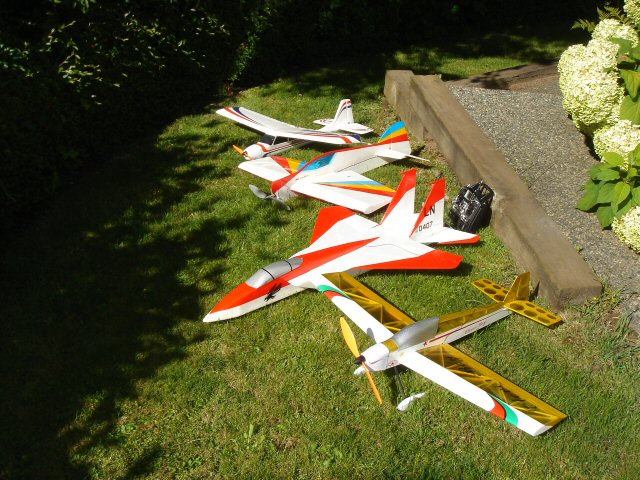
Contents
Stealth B2 Bomber, from AirTech

|
-
Purchase Price: $79.99 cdn. from Toys-R-Us.
-
Comes complete with controller, NI/MH battery for aircraft, and charging
station.
-
Other costs required before first flight: aprox. $30.00 cdn.
-
Requires 8 AA batteries for remote control
-
Requires 6 D batteries for aircrafts' battery charging station (I use a generic
quick-charger instead)
|
Some Stats
Weight: 120g
Thrust: 25g x 2
Battery: 300mAh, 4.8v, 4-pack of 2/3length AAA batteries, configured in a 2x2
matrix.
Wing Span: 700mm
Propellor: 75mm x 2
Material: EPP
Class: Park Flyer
Controls: Throttle, Ailerons, Elevator (through differential thrust - so aerobatics are not possible)
Homepage: Interactive Toys - Replacement parts and information.
NOTE: Mine was shedding stickers even before the first flight. But that's ok, a
B2 should be solid black anyway :-) As you can see, the profile of the wing is
not flat, it has angles along its' length. But when it's in the air, you'd
never know. It looks like a perfect silouette of a B2 as it flies over you.
There are no stickers on the bottoms of the wings, but there are stickers on
the sides of the lower body. They are not visible as it flies over.
The aircraft is built of strong EPP Foam. It can withstand nose-dives from
insane altitudes (I've tested it myself several times). If you *DO* manage to
break something, all it takes to fix-er-up, is some "white glue", such as the
stuff used in public schools. Then after it's dry, tape the area (with black
electrical tape) for extra support, and off you go again! Note that this model
has a very gentle glideslope, and has no elevator, so you really have to look
ahead to avoid potential disasters. If you're getting into trouble, it's a long
glide before you can land it.
E-Starter, from GWS
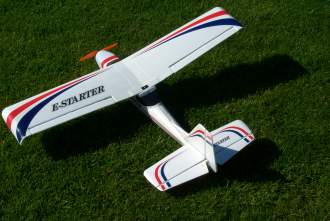
|
-
Purchase Price: $79.99 cdn. from local R/C Hhobby Shop.
-
No controller with this one - you must take the leap and purchase a
generic R/C aircraft transmitter. They will run you anywhere from
about $80 to $500+ if you want computer assistance such as mixing.
A mixing feature allows you to, for example, add more rudder as you
use the ailerons (for automated co-ordinated turns),
and many other things. On the bright side, once you've made this
purchase, you will be able to fly many other model aircraft with the
one transmitter.
-
Other costs required before first flight:
- Glue (optional - the kit did come with some mystery-brand glue, but I didn't use it)
- Standard R/C aircraft parts (reciever, servo's, ESC, etc. )
|
Some Stats
Weight: 15oz
Thrust: (Unknown)
Battery: 750mAh, 9.6v, 8-pack of 2/3length AA batteries, configured in a 3x3 configuration.
Wing Span: 37.8 inches
Propellor: gws 7035
Material: Foam
Class: Park Flyer
Controls: Throttle, Ailerons, Elevator, Rudder.
Homepage: GWS
The aircraft is built of strong foam. It can withstand some pretty rough landings, but the
landing gear is often liberated from the fuselage. If you do manage to
break something, all it takes to fix-er-up, is some more glue to slap'er back together.
Foam is easy stuff to fix :-) unless you manage to crash at such a rate of speed that the
foam shatters into too many small pieces. I've not done it, but I'm sure someone out there
has found a way.
StickPlane, (my experiment)
| no image
|
-
Purchase Price: $cheap.
-
This thing was thrown together with some foam, 2 servo's, a motor,
and the Rx and ESC from my E-Starter. I built it to see if I could
build something light enough to fly. It did! But it sure wanted
to do left turns a lot! (not well balanced, but then I didn't spend
long balancing it). It made 3 flights total. 1st flight was really
squirly, and ended in a rough but ok landing. 2nd flight was much
better. I flew several nice circles around myself (to the left),
and finally landed it gently. 3rd flight took the path of a lawn dart.
(the elevator linkage had come off but I didn't check before pitching
it up into the air with full throttle)
|
Some Stats
Weight: (Unknown)
Thrust: (Unknown)
Battery: 750mAh, 9.6v, 8-pack of 2/3length AA batteries, configured in a 3x3 configuration.
Wing Span: (Unknown)
Propellor: (Unknown)
Material: (Unknown)
Class: Park Flyer
Controls: Throttle, Ailerons, Elevator, Rudder.
The aircraft is built of strong foam. It can withstand some pretty rough landings, but the
landing gear is often liberated from the fuselage. If you do manage to
break something, all it takes to fix-er-up, is some more glue to slap'er back together.
Foam is easy stuff to fix :-) unless you manage to crash at such a rate of speed that the
foam shatters into too many pieces. I've not done it, but I'm sure someone out there has.
Attitude 3D Profile, (Todd's Models)
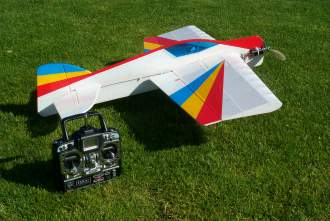
|
-
Purchase Price: $79.00 CDN.
-
This aircraft may look a little funny, but it is VERY powerful.
It can stand on it's nose, and hover on the prop thrust alone (and that's only at 1/3rd throttle, too!)
It has a "profile" fuselage, meaning light, strong, and very low drag.
It has full-span ailerons with 45' throws, allowing it to loop within it's own length,
as well as a giant rudder and elevator. All this adds up to more power and control input than the
aerodynamics of the aircraft can handle, thus the term "3D".
It's possible to do unusual aerobatics by flying on the boundary between "in" and "out" of the flight envelope.
An example being hovering, where the aircraft is fully stalled (it's not moving anywhere,
so there's little airflow over the wings), however, there is enough airflow from the prop-thrust
passing over the control surfaces, for the pilot to continue controlling the aircraft and keep it
balanced in the upright position. Alas, Todd has discontinued this amazing model :-(
|
Some Stats
Weight: 19oz
Thrust: 47oz
Battery: 2100mAh, 11.1v, TP2100, 16amps static.
Wing Span: 34 inches
Propellor: 11x4.7 slowfly
Material: Balsa with SoLite covering
Class: Park Flyer
Controls: Throttle, Ailerons, Elevator, Rudder, (Flaperons).
Homepage: Todd's Models (Attitude is discontinued)
The aircraft is built of balsawood (mostly competition quality), and has a very light and strong frame.
The wing spars had a built-in jig to assist in the building process, and worked very well.
The plane can do everything I hoped it could do, and will last me a long time, I'm sure :-)
XF-11 (My second scratch build)
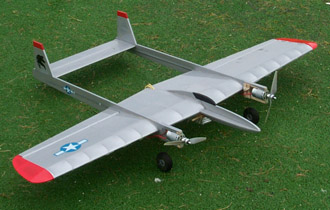
|
-
Purchase Price: No idea :-(
-
This plane was inspired by an accident I had
with my Attitude. I settled on a P-38. Mid-way
through design, I saw the movie, "The Aviator", and was very surprised to see a
plane that looked like a P-38, but had a more square tail rather than the egg-shaped
thing the P-38 had. I like squared-up tails much better, so the design quickly
changed. It's taken about 2 months of planning on the computer (and learning CAD),
and another month or two of actual building time, but it's finally complete.
It's a FAST plane :-) 30kph stall, 70kph max speed. Scares the snot out of me
when I fly it.
|
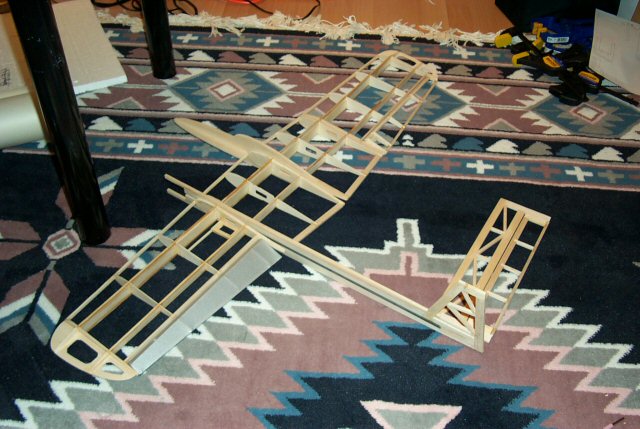
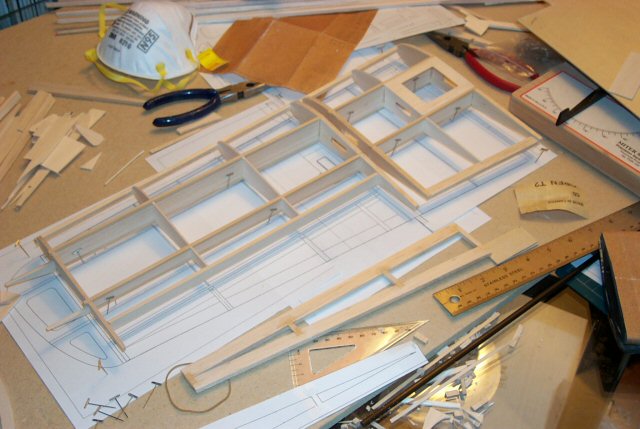
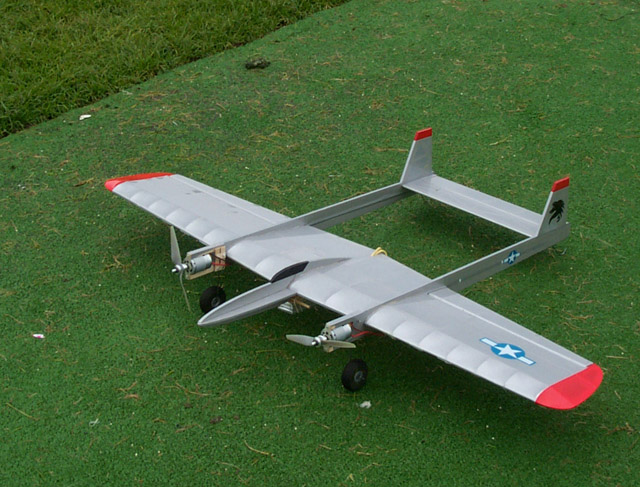
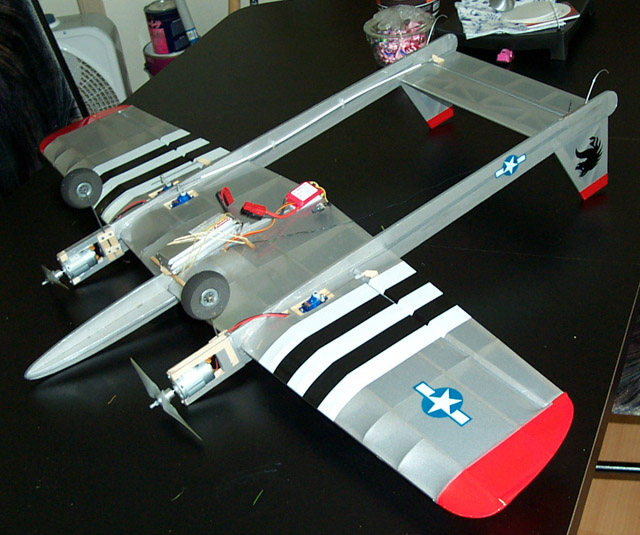
F-15, (jetset44's free plans)
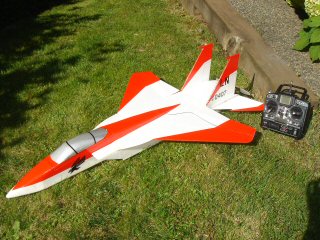
|
-
Scratch Build - cost of parts: $20.00 CDN, (plus electronics).
-
What can I say. This is an absolutely brilliant design. I looked at it online, and I read the
newsgroups where other people discussed their build, and their first flights, and how some had less
than successful first flights, and I feared this whole jet thing very much. But I built it anyway.
And WOW, am I ever glad I did. This thing was easy to build, and flies SOOOO NICELY!
And it looks absolutely stunning in the air, especially going vertical. It has enough speed to
scare me when I crank up the throttle for a low pass, and it can slow right down for a very gentle
belly-flop landing. It's a lot of fun to fly something that knocks people's socks off when they
see it, and jets seem to do that every time. What more can you ask for, and it's FREE!!!
-
Additional parts needed: 3 HS-55 or similar servo's, motor, reciever,
and a bit of scratch-building experience.
|
Some Stats
Weight: 16oz
Thrust: 18oz
Battery: 2100mAh, 11.1v, TP2100, 10amps static.
Wing Span: 28 inches
Motor: AXI 2212/26
Propellor: 9x6 slowfly
Material: FoamBoard with SoLite covering for color and strength
Class: Park Flyer
Controls: Throttle, Ailerons (Flaperons), Elevator.
Homepage: www.3dfFoamy.com <-- Free plans here
This model is made entirely of foam-board (the foam with paper on both sides, that you can make signs with).
Soak it in the tub for an hour, and you can peel off the paper. No glue was used to apply the paper,
so it comes off cleanly. SoLite Covering was used, to create the color scheme, while also adding
strength to the leading-edges of the wings. I also added balsa strips to the vertical tail, for a touch
more rigidity. The nose art and tail markings were created by printing black&white clip-art and numbers,
and then peeling the backing off some black covering, and sticking it to the back of the printed paper.
Then, I carefully traced the printed items with an exacto blade. After cutting out, separate the paper from the
covering again, and apply the covering to the aircraft. Black makes very nice decals this way. Some other
colors are too transparent on their own. Yellow can be made more opaque by putting white behind it.
Anyway, on to the test flights. On day two of flight
trials, I had just finished a high speed pass, and was going vertical when something flew off the
aircraft. That freaked me out pretty good. I cut the power, and coasted around for a quick landing,
and discovered it had shed the (taped-on) canopy. I found the canopy, but had no idea where the tape went.
Until my buddy pointed out it was stuck to the leading edge of the right vertical tail. (The canopy is
removable since the battery is under there). Now it's held in place with a screw.
Update: The screw solution failed within another two weeks. Another canopy lost! I couldn't find it,
as it has flown off the plane somewhere out over the swamp.
A new canopy has been constructed, this one is being held in place with a magnet.
Update: The magnet held canopy has been holding very well, it's bee about a year and a half now.
I just headed out to the field the other day, and would you believe my old canopy is sitting at the edge of the
staging area??? It looks like it's been used as a dog chew-toy, but it's definitely my canopy#2 (held by a screw).
You can see how much my sculpting skills had improved by the 3rd version of the canopy :-)
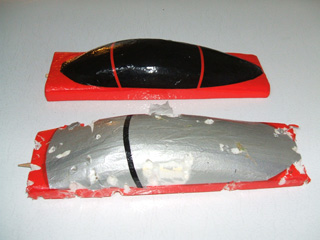
Clever Boy ARF, (Green R/C Models)
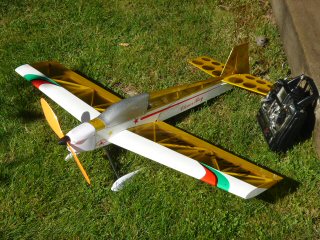
|
-
Purchase Price: $200.00 CDN.
-
This lovely little 9oz aircraft was a prize I recieved at the local fly-in,
one sunny afternoon. I couldn't believe my luck.
Credit where credit is due -
Racing Devil Hobbies of Richmond BC
supplied the prize, and I cannot thank them enough for it.
It flies like a trainer, and with enough power to loop, or climb aggressively
at about a 45' angle. This model is an ARF - meaning "Almost Ready To Fly".
Open the box, and find an aircraft that's mostly built already - just need to glue
the tail to the fuselage, mount the servo's of your choice, add a reciever,
and you're ready to go. It is already covered, with some sort of plasic
shrink-covering like I use on my other models, but this stuff is much stronger,
and would likely resist a puncture if it encountered a tree.
-
Additional parts needed: Glue, 3 pico servo's, and a reciever.
|
Some Stats
Weight: 9oz
Thrust: unknown
Battery: 650mAh, 9.6v, 8-pack of 'AAA' NIMH batteries, in a 2x4 configuration.
Wing Span: 36 inches
Propellor: "Tower Pro" EP-1030 slowfly
Material: Plywood and Balsa, with unknown brand of covering
Class: Park Flyer
Controls: Throttle, Ailerons, Elevator, Rudder
Homepage: none known
Extra 300 ARF, (Extreme Flight R/C)
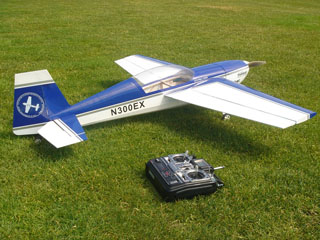
|
-
Purchase Price: $200.00 CDN.
-
This beautiful airplane is a highly aerobatic aircraft weighing
about twice that of the Attitude.
Because of it's increased size, it is capable of fighting the wind
much better, as well as following a line much more accurately.
It's also a bunch faster. The paint-scheme for this plane was obviously
inspired by Patty Wagstaff's
Extra,
which she flys at airshows around the world. (This plane is also
available in Red, but I chose Blue since everything else I own seems to
have a lot of Red). It takes a slightly larger area to fly in than my
Attitude. The wings are removable, and
the best part is that this plane can fly on the same batteries my
Attitude uses, so it saves me money
in the Lipo department.
-
Additional parts needed: Glue, 4 micro servo's, a motor, and a reciever.
|
Some Stats
Weight: 34.5oz
Thrust: unknown
Battery: 2150mAh, 11.1v, EVO20 FlightPower, 35amps static.
Wing Span: 45 inches
Propellor: 12x6E SloFly
Material: Plywood and Balsa, with Ultracoat/Oracover covering
Class: Park Flyer
Controls: Throttle, Ailerons, Elevator, Rudder
Homepage: www.extremeflightrc.com
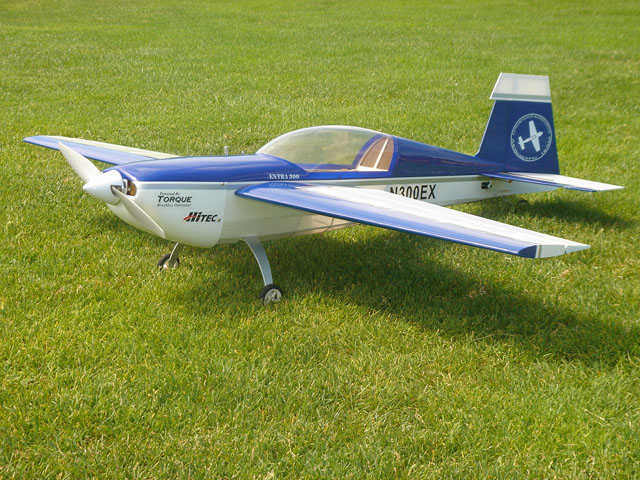
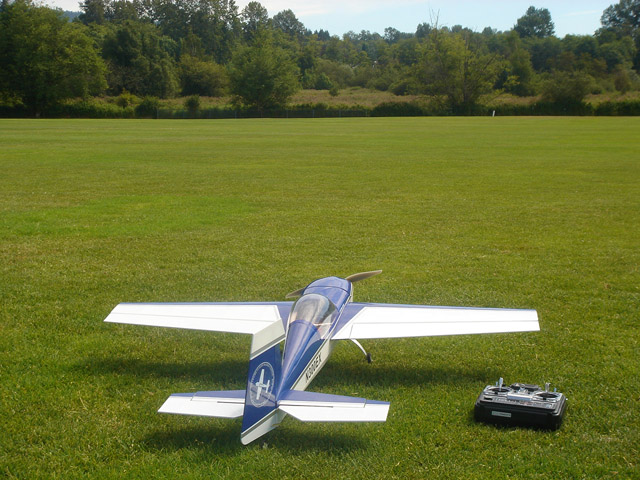
The aircraft is built of plywood and balsa, and has a very light and strong frame.
The motor mount has a spring-action, so if you nose-in, there's a chance you won't
bugger up the model. I hope never to test this feature. The wings have quite a bit
of dyhedral, making the plane naturally return to level flight if you stop steering.
Stalls are the one drawback of this model. The model also sports some nice little
carbon-fiber landing gear. This is the only model I own which can taxi on the grass
(which is of very poor up-keep) at the local flying field. AND, it sports a
tail-wheel tied to the rudder, which is really nice!
In flight, a stall with this model means one wing
drops REAL QUICK, and you're in a nose-down vertical position before you know what
happened. It's a real floater though, so you have to kill the throttle, then hold
the nose high as it slows down, to even induce a stall. As long as you let it glide
itself (without power), it's happy. I think this plane needs to acquire some lights,
for a little night flying, sometime soon :-)
Twinkle (TheKM's plans)
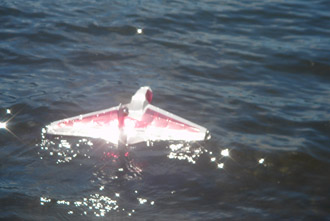
|
-
Purchase Price: N/A (scratch build from magazine fold-out plans)
-
This little plane is the smallest thing I've built so far.
It's tons of fun on the water, and can scoot around on the
surface or pop up into the air and fly as well. I did build
it a bit on the heavy side, so I won't fly it anywhere unless
I have water to land (or crash) on. It definitely needs gentle
or no waves at all, since it's such a small plane. If I build
another one, it will be at about 125% size, so that I can use
my same hardware again on an airframe large enough to carry the
weight easily.
|
Some Stats
Weight: 10oz
Thrust: unknown
Battery: 550mAh, 7.4v, 10amps static.
Wing Span: 24 inches
Propellor: 6x4
Material: Balsa
Class: Park Flyer, Float Plane
Controls: Throttle, Ailerons, Elevator, Rudder
Homepage: keyboardmonkey.com/twinkle
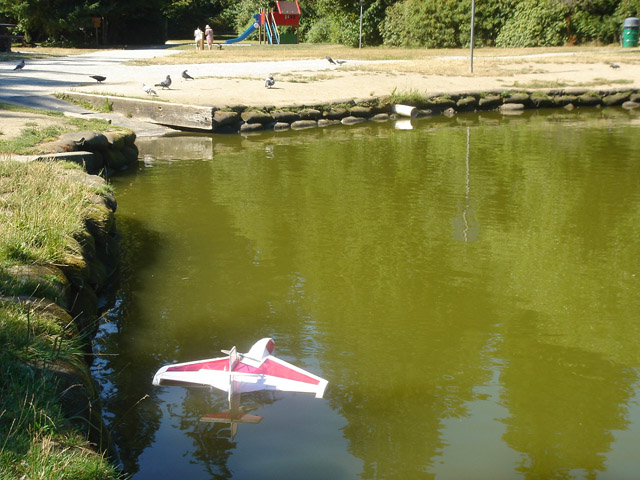
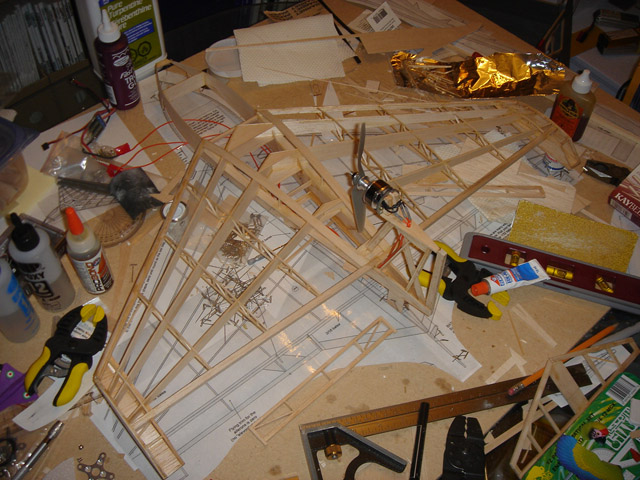
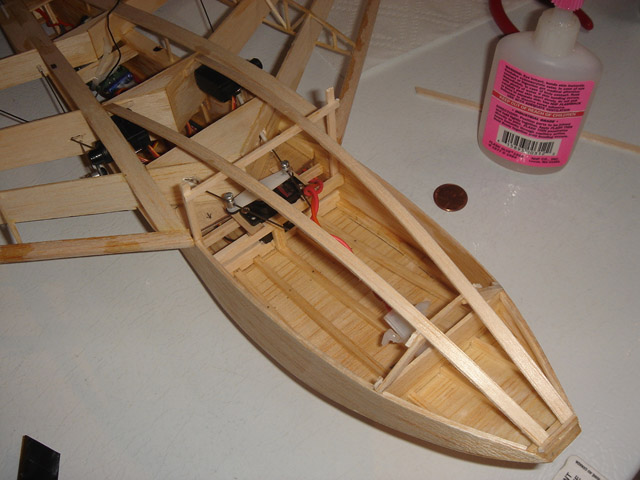
Flatouts Extra
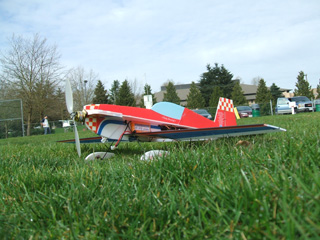
|
-
Kit Build - cost of parts: Unknown (A very kind gift from Gerry).
-
This is a great little plane to go with my big Extra.
It can be flown in the smallest parking lot or park, even inside a baseball diamond.
|
C-47 / DC-3 (GWS)
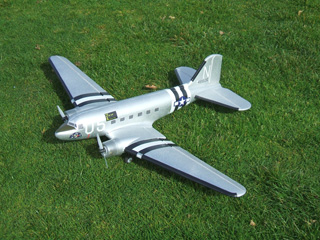
|
-
Kit Build
-
This is a speedy twin-engine plane. I've been having difficulty with C/G and stall
characteristics since I built it to use Lipo batteries rather than the NIMH it was
designed for. It also suffers from engine surges, something to do with the dual
electric engines running from the same ESC (yes, they're brushed motors).
|
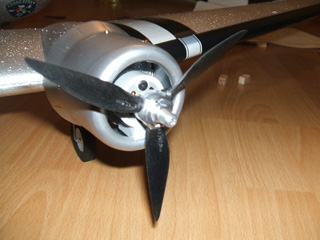
The C-47 now sports some nice 3-bladed "VarioProps".
Saab Gripen, (jetset44's free plans)
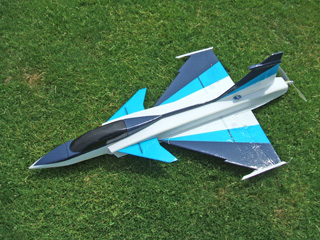
|
-
Scratch Build - cost of parts: $20.00 CDN, (plus electronics).
-
Another great design by Jetset44.
I built this one after having a good 200+ flights on my F-15.
After so much time with the F-15, it wasn't feeling as fast anymore (I'm just used to it now),
so I decided it's time to make something faster again :-)
I knew this design should fly similarily to the F-15 since it's the same approximate weight and size.
I chose a slightly faster motor/prop combination, and started building.
Final result: A plane that's a blast to fly, although a hair more difficult to control than the F-15.
Slightly more twitchy, and a stall that's a bit scarry at low altitiude. At least on my setup,
the canards will stall before the main wing, and will send the plane from a nice calm high-alpha
position, into a horrifying nose-first dive in no time at all. It sure is fast though, and can climb
so quickly it could be out of sight before you really appreciate how fast it's going.
-
Additional parts needed: 4 HS-55 or similar servo's, motor, reciever,
and a bit of scratch-building experience.
|
Some Stats
Weight: 16oz
Thrust: 21oz
Battery: 2100mAh, 26amps static.
Wing Span: 26 inches
Motor: AXI 2212/20
Propellor: 9x6E
Material: FoamBoard with SoLite covering for color and strength
Class: Park Flyer
Controls: Throttle, Ailerons (Flaperons), Elevator, Rudder.
Homepage: www.3dfFoamy.com <-- Free plans here
See the F-15 for how this model was made (similar process).
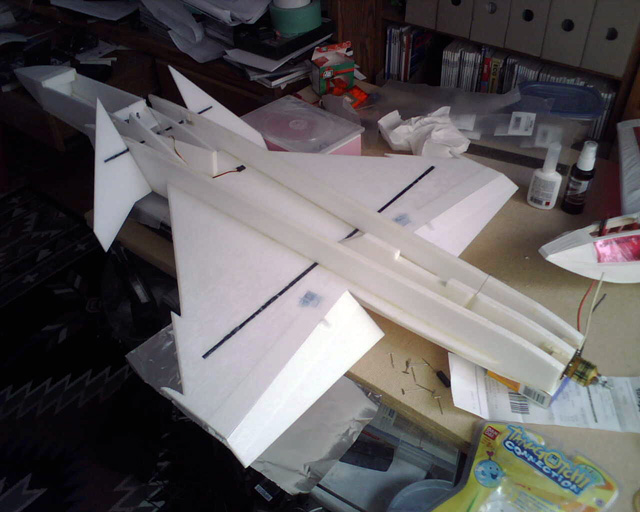
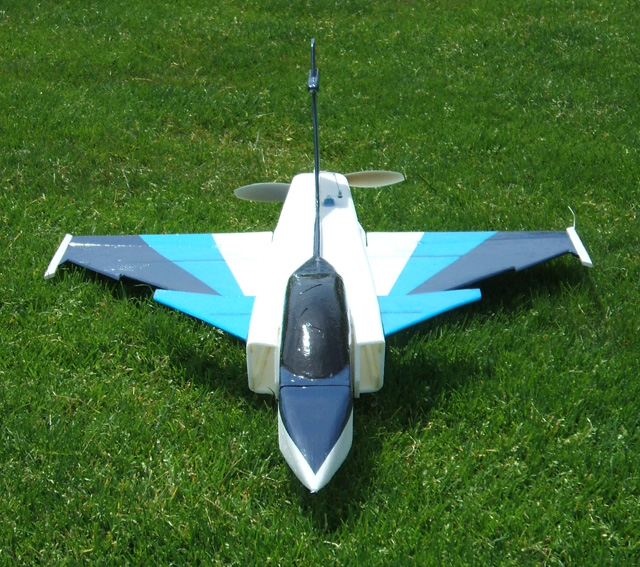
Seawind, (Electrifly)
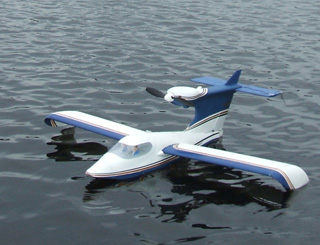
|
-
ARF - cost of kit: $99.95 U.S. (plus electronics).
-
This is a very easy to build, all-foam aircraft.
All foam = low maintenance when water is involved.
The manual claims that only 2 hours are needed, to build this model.
I'd call that a mighty aggressive claim.
BUT, it is extremely easy to build if you've built an ARF before.
If you haven't, then the manual is above average in quality and
should help you get through the build without any major oops's.
The kit comes with extra bits, which, when put together, create a balancing jig, and a build/display cradle. How nice!
When discussing water handling, I'll compare it to my twinkle, since that's the first water-plane I had.
The good:
Almost everything. Using the recommended motor, this plane flies great!
Lots of power for pretty much any maneuver, and the plane can slow down quite nicely too.
Not 3D, but then having the motor above the wing would really NOT make for good 3D handling, regardless.
You can hand-launch the plane (45 degrees nose-up), and belly-land on grass too.
The bad:
This plane has some water handling issues. They are minor, but they are definitely there.
It's really, REALLY difficult to turn this plane in the water.
My twinkle can turn in a circle at low speed, about 3x it's own wingspan.
The Seawind takes something closer to 5 car-lengths to get turned around,
and often simply refuses to respond at all to control-inputs (to turn) while on the water.
The water rudder is pretty much non-functional, I think it's the wind over the rudder from the prop,
that's actually turning it, but that only works well when at the exact right ground-speed.
In the air too, the rudder is almost non-functional. No hope of a knife-edge.
Overall, I'd highly recommend this plane, the rudder issues can be fixed if you want to add
a big paddle in place of the skimpy little piece of plastic currently functioning as the
water rudder (easy post-build change). Or you could just live with it, it's not a killer problem
as long as you start your turns early.
-
Additional parts needed: 2 HS-55 servo's (aileron/elevator), 1 HS-65 servo (Rudder), motor, reciever,
and a bit of ARF-building experience would help too.
|
Some Stats
Weight: 25oz
Battery: 1500mAh, 3S1P.
Wing Span: 40 inches
Motor: RimFire 950kv
Propellor: 8x6
Material: Foam, with some plastic sheeting for durability around the forward hull.
Class: Park/Water Flyer
Controls: Throttle, Ailerons, Elevator, Rudder.
Homepage: www.electrifly.com
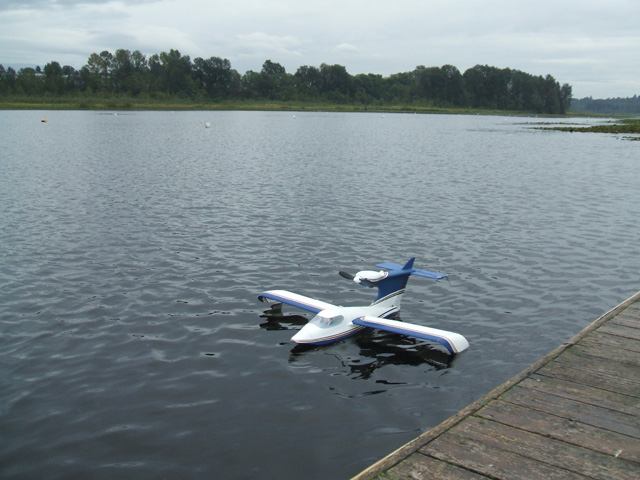
VIDEOS
(right-click and save to harddrive). They are AVI format.
MEMORABLE CRASHES
Most of these stories date back to the very first flights I experienced.
Well before I discovered the local club.
Death Spiral 101:
Heading for the forest at about 80 feet. Don't want to go there. 3rd day out
flying. What to do? Hold maximum left throttle, Captain! The aircraft tips over
on it's side. It's a B2! There's *NO* lift when it's sideways, Captain! The
aircraft drops into a vertical spiral, and within about a second, has
accelerated to an ungodly rate of speed (I'm *still* holding maximum left
throttle). It then nose-dives into a loose-gravel area surrounding a (vacant)
swing set on the edge of the forest. Damage? none, to my total amazement.
Fencing:
There's a chain-link fence down the center of the park, separating the baseball
diamond from the soccer field. It's of average height (4-5 feet). I'm all over
the place, seeing as I've only been out a few times and am still getting used
to simply turning. I've crossed the fence a few times and returned it
successfully, but one time, after completing a turn on the other side of the
fence, I find myself dropping in altitude as I approach the fence to return to
my side of the field. As I see my plane drop below the line of the fence, and
see that it is, indeed, still on the other side, I decide to floor it, in hopes
of 'hopping' over the fence. No such luck. The plane rises, but just as it's
about to clear the fence-line again, it instead, meets the fence. As it skids
over the top of the fence, something catches on the underside of the plane
sending it cartwheeling end-over-end through the air. When it finally lands on
the ground again, I pick it up and inspect it: minor foam separation on a funny
foam bump in-front of the on/off switch. I suspect that foam is there just to
protect the switch anyway, so no harm done.
Girlfriend Gets the Controls:
I'm stupid. But only because I picked the *DUMBEST* spot to give my girlfriend
a chance at the controls. Small park, lots of fencing, trees, pools, etc. etc.
very near by. No people near by. NOT GOOD ENOUGH :-) I show her the controls,
tell her to hold full throttle, and then I give it a throw. The plane rises,
and banks off to the right, and then BZZZZT. Stuck in a tree. Fortunately, it
happened so fast, it was just barely out of reach. I got a hoola-hoop I had in
my trunk, and tried to snag it, but couldn't :-( I also tried bungie cables
from the trunk, still no luck. I could reach the base of the branch with my
plane on it, and bounce up and down and shake the shit out of it, but the tree
just won't let go :-( At this point, some nice people come by with a big pole
they had in their trunk, and I was able to poke the plane out of the tree. They
then advise me that there is a HUGE open park just over that rise. sheesh :-)
Off we all go to do a little more flying :-)
40-feet and climbing:
I took my plane out to a nice park I found that is completely enclosed by
trees, and seems to always be virtually devoid of people, save the odd BBQ'er
around the edge. I go to the center of the field, and give it a throw, fly it
around a bit, then practice a landing over near the corner of the field. I walk
over, and pick up the plane. At this point, two kids intercept me and ask if
I'm putting on an "air show". I tell them I'm still learning, and then launch
the plane again. Notice, I forgot to go back to the center of the field :-( It
flies out over the field, then I bring it back around to me again.
Unfortunately, I'm not thinking far enough ahead, and when it gets to me, I'm
screwed. It's way up high, and I realize as soon as it's close, that it's
destined to go into the trees. I just watch helplessly as it does just that.
Getting this one down took about 4 hours of my life, and most of my sanity. I
must have thrown various things into the tree 40 times. Then I got rather warm,
so I removed my coat. I eventually got the plane down by throwing a hammer
(with a string attached) over the branch which was holding the plane. Once I'd
finally accomplished that, I tied an extension cord to the string, and then
pulled that over the branch and down the other side. Now I had something strong
enough that I was able to bounce the branch vigerously, until the plane was
released. What a project. I was SO happy to *finally* have my plane back, that
I forgot my coat at the tree instead :-(
Things that go "PING!"
When an aluminum bat strikes a baseball, you hear a sharp PING! sound.
Today, I discovered that my styrofoam stealth, when striking an aluminum pole,
produces a remarkably similar PING! sound. It also induces an uncontrollable
tumble that would cause even the most extreme pilot to black out.
Unfortunately, the subsequent collision with the ground caused the right wing
to be severed about 2 inches from the wingtip :-( This is a very thin part of
the wing, and only time will tell if glue will hold the wing together in this
area. This may be the beginning of the end of my first aircraft :-(
Preliminary test-flights seem to indicate the repairs will hold just fine :-)
Things that make you scream "NOT NOW!!!"
For one, if you're hovering your plane just above head height, and the battery
cuts out, that's a good time to scream "NOT NOW!" Because that's about all you
can do while you watch your plane tail-slide most of the way down, then flip
over just in time to crater into the ground. That little accident caused the nose
to bust clean off, whip around and use the spinning prop to chew the first two
ribs clean off the left wing. The right wing didn't get away unscathed either, it
lost two outer leading edge ribs as well. During the impact, the tail bent over
so far I swear the tail almost touched the ailerons, then, remarkably, sprang
back streight again. I couldn't believe my eyes. I was heart broken.
My beloved Attitude was done for the day.
I contemplated buying a new kit, but then a week later, gathered the courage to
try to fix my (first) balsawood kit. It turned out to be really easy, even building new
ribs!!! I just scanned the originals from the plans, printed them on paper, and
made sure they printed at 100%, not 97% like my printer wants to do by default
(WHY!?!?!?!), and used them as templates to cut and sand new balsawood. It took
all of one evening to rebuild the leading edges of both wings, I was very surprised.
Things went so well, I was inspired to try to build my own aircraft from scratch.
The XF-11 was the result!
And yes, my Attitude still flys just fine :-)
War Wounds
My stealth has seen some pretty harsh crashes. Here's it's current condition:
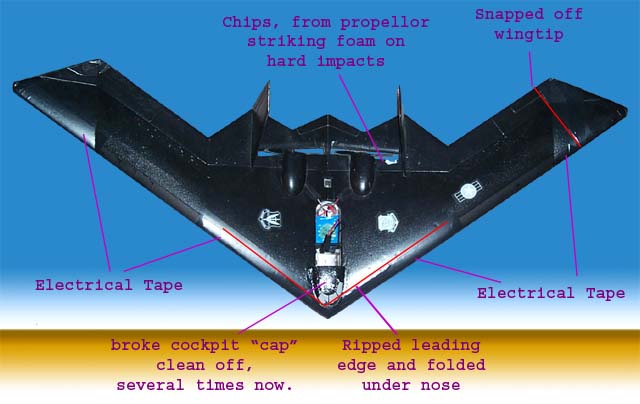
My XF-11 after test-flight #3. I stalled it with the flaps down and not enough
throttle. I have re-built it from the parts, it went back together like lego.
I will not likely fly it again, but keep as a static model.
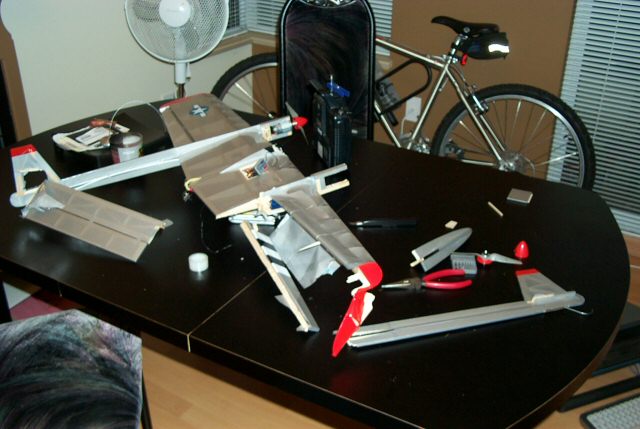
My Attitude has been through many an accident. It has had it's nose snapped off
2 times, as well as broken most of the ribs across the leading edge of the wing
at-least once. But it keeps on flying :-)
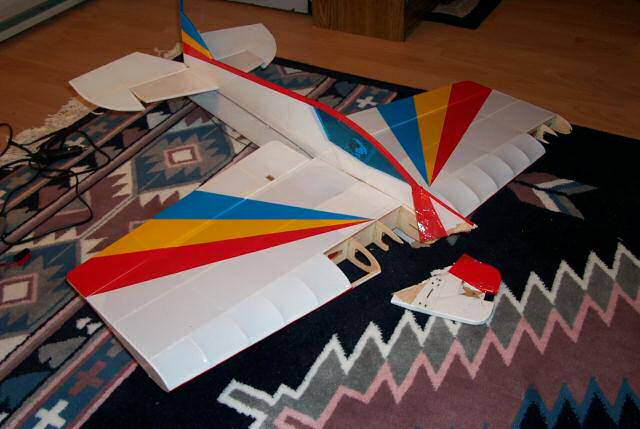
My friend Gerry made a BEAUTIFUL Snowbird out of a Formosa II.
I had the honors of being the guy to cut it in half during a mid-air.
I came out of a loop, on the down-side, and cut right through his snowbird.
I spiralled down into long grass & dandilions, which pretty much saved my plane,
but his snowbird went in like a lawn dart and had severe damage to the nose of the
plane, making repair of his motor mount pretty much impossible. His spinner was
stuck in the dirt by 2 inches, and stayed there when he pulled the plane out.
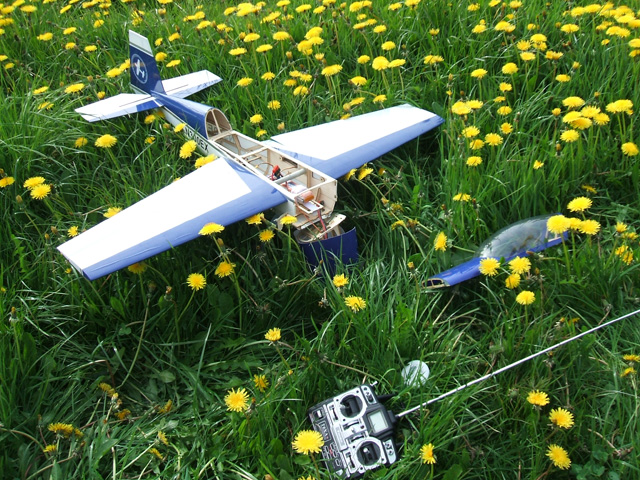
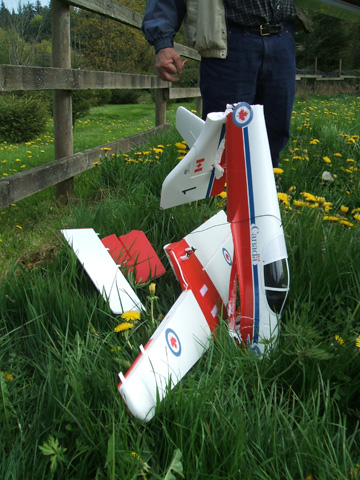
Back to my site




























